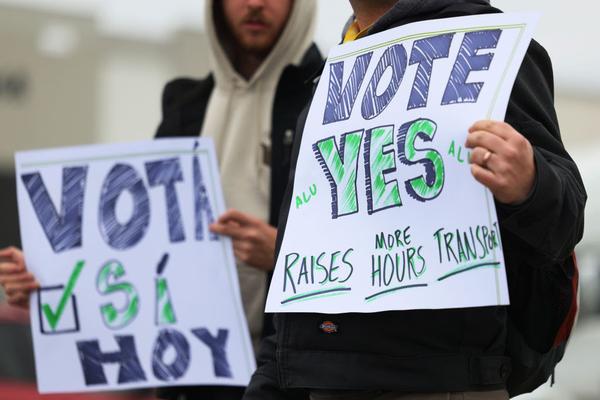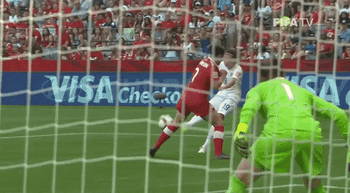A deep dive on labor in sports

📚 The details
The North American labor movement began out of a need to protect workers’ common interests. While workers tried to use their collective power in the free wage labor market for years, it was the Industrial Revolution that really saw the beginnings of labor unions.
So what is a union? A union is an organized group of workers who make decisions about the conditions at their place of employment. They function democratically, holding elections to choose representatives who negotiate with the employer on behalf of all members.
- Representatives do this through the process of collective bargaining, where the union negotiates contracts and decides the terms of employment, like pay, benefits, hours, and health and safety policies.
We have unions and the labor movement to thank for things like ending child labor, ensuring safe working conditions, creating the 40-hour work week, and compensating employees injured on the job.
Fast forward to today, hot labor summer is in full force. From the ongoing Writers Guild of America and SAG-AFTRA strikes, employees are raising their voices and fighting for their fair share.
- But there’s still a lot of work to be done, particularly for women. Luckily, female athletes are getting in on the bargaining game and scoring big wins along the way.
⚽ Women’s soccer: LFG

SOURCE: FRED KFOURY III/ICON SPORTSWIRE VIA GETTY IMAGES
After a banner 2022 for women’s soccer unions, the fight for equal pay and equal treatment continued on the international stage this year.
Starting with the progress, in January 2022, the NWSL and NWSL Players Association (NWSLPA) agreed to their first-ever collective bargaining agreement (CBA) in the league’s 10-year history. About damn time.
- Amidst the negotiations, in 2021, the NWSLPA launched a campaign called #NoMoreSideHustles, with some players detailing the extra jobs they had to work to support themselves on the league’s paltry $22K minimum salary.
- The NWSLPA’s around 200 members netted significant gains in the CBA, including a 60% minimum salary increase with guaranteed annual raises, free agency for NWSL veterans, parental leave, and physical and mental health benefits.
Then, in May 2022, the USWNT Players Association (USWNTPA) shattered a glass ceiling with a historic CBA of its own. After years of contentious litigation and negotiation, the U.S. Soccer Federation struck equitable labor deals with both the women’s and men’s unions. Truly, one nation, one team.
And the battle for footy equity marched on from there. In the leadup to this year’s FIFA Women’s World Cup (WWC), CanWNT found themselves in a labor dispute, which included threats of a strike before the squad reached an interim funding agreement with their federation.
- The WWC–winning Spanish women’s national team is also no stranger to collective action. In September 2022, 15 players boycotted under current coach Jorge Vilda, and since their win, over 80 players have refused to play until the embattled Luis Rubiales is ousted.
💰 NCAA: NIL and the end of free labor

SOURCE: GREG FIUME/NCAA PHOTOS VIA GETTY IMAGES
College sports have historically been untouched by discussions of labor organizing, primarily because the NCAA has always prided itself on amateurism, prohibiting any compensation for its athletes outside of scholarships and basic educational expenses.
- The main problem with that? Student athletes’ labor filled everyone else’s pockets. NCAA schools leveraged revenue driven from massive media rights deals and things like ticket and merchandise sales, generating nearly $19 billion (!!!) each year.
- As for the players? They were left risking life-altering injuries for subsidized education and living expenses (under $36K annually). The math was not mathing.
Then, on July 1st, 2021, the NCAA finally allowed athletes to profit off their name, image and likeness (NIL) by signing endorsement deals with companies. But the watershed moment only came after the NCAA was dealt a huge loss in the Supreme Court.
- In the two years since, college athletes have raked in nearly $2B from brands, and schools have gotten in on the game by hiring NIL specialists along with creating marketplaces to help students rake in the big bucks.
But this may not be the end of the collegiate labor dispute. Despite the massive impact of NIL, a more traditional employee/employer relationship could be coming down the pipe, with the NCAA facing multimillion dollar lawsuits and rumblings of an athlete union and CBA to be negotiated. Watch this space.
⚾️ MLB: Knocking inequity out of the park

SOURCE: THE WALL STREET JOURNAL
Last year brought a major labor win on the diamond — after years of organizing, players in Minor League Baseball (MLB’s feeder system) finally unionized. While big leaguers have been represented by the MLB Players Association (MLBPA) since 1966, over 5K minor leaguers had no union and were paid measly salaries (below the federal poverty line).
- Those unacceptable wages were sadly coupled with poor working conditions. In 2021,
Fyre Fest–inspiredphotos of food served to Oakland Athletics minor leaguers went viral, bringing a much-needed spotlight to the pervasive problem. Blech.
But change finally came last September, when MLB voluntarily recognized the first-ever minor league union. That victory was followed by the inking of the first minor league CBA, which featured improvements including guaranteed housing, food and facility standards, and access to NIL opportunities.
🏀 WNBA: Count it

SOURCE: STACY REVERE/GETTY IMAGES
As per, the WNBA leads the way when it comes to labor rights in women’s sports. The aforementioned WNBPA formed in 1998, just two years after the league was founded. In fact, the WNBPA was the first-ever labor union composed of pro women’s athletes.
- In the glorious year of 1999, the WNBPA negotiated the first CBA in women’s pro sports history. That deal included the implementation of year-round health insurance along with a nascent maternity policy. It’s a marathon, not a sprint.
- The W’s operated under four CBAs since, most notably signing a historic agreement in 2020 which brought much-needed salary increases, fully-paid maternity leave, and improved travel, among other massive wins.
With that progress in mind, there’s still ample room for improvement, as made apparent by the widespread and well-documented travel issues that have plagued the league the last few seasons.
- Despite the travel enhancements from the 2020 CBA, players (who are often over six feet tall!) usually still fly commercial, which brings its own set of problems.
- After a series of frustrating incidents and advocacy from the WNBPA, the W did expand charter flights ahead of the 2023 season, with teams traveling charter for back-to-back regular-season matchups and playoff games.
- That said, new reporting has found that playoff charters come with “stipulations.” As we look ahead to postseason action in two weeks, the work continues.
Enjoying this article? Want more?

Sign up for The GIST and receive the latest sports news straight to your inbox three times a week.

